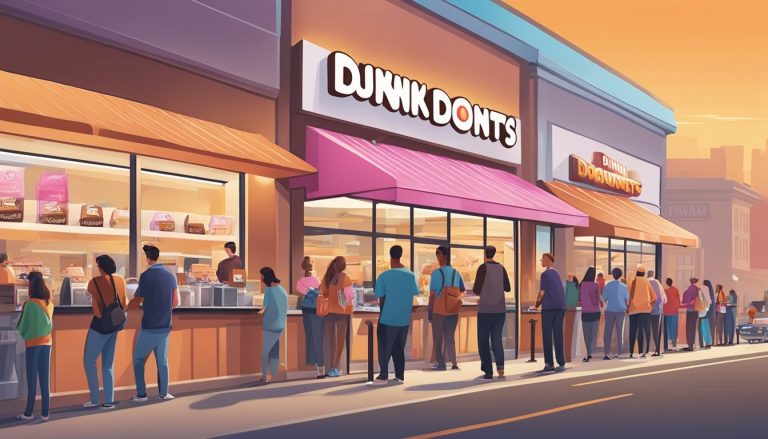Dunkin’s introduction of all-day breakfast has ignited a fierce competition in the fast food industry. This move has transformed the landscape of morning meal offerings, extending beyond traditional breakfast hours to cater to changing consumer preferences.
The impact of Dunkin’s all-day breakfast strategy has been particularly significant among younger demographics. Gen Z adults aged 18-24 and Millennials aged 25-34 are driving the demand for fast-food breakfast, with 77% and 66% respectively opting for it at least 1-3 times per month. This trend contrasts sharply with older age groups, who are less likely to order fast-food breakfast.
The breakfast battle has become a key battleground for fast food chains, with companies constantly innovating to capture market share. Dunkin’s latest breakfast creations aim to differentiate their offerings and attract customers throughout the day. As the fast food breakfast market continues to grow, reaching $31.7 billion in sales in 2012, chains are recognizing the potential for increased revenue and customer loyalty through expanded breakfast options.
The Evolution of Dunkin’s Breakfast Menu

Dunkin’ has transformed its menu from simple donuts and coffee to a diverse array of breakfast options over the years. This expansion has shaped the company’s identity and influence in the fast food industry.
From Donuts to Diverse Breakfast Options
In 1950, Dunkin’ began as a single shop in Quincy, Massachusetts, focusing primarily on donuts. As customer preferences evolved, so did the menu. In the 1980s and 1990s, Dunkin’ introduced muffins, bagels, and breakfast sandwiches to cater to changing tastes.
The company’s breakfast offerings now include a variety of sandwiches on bagels, croissants, and English muffins. Wraps and bowls have also joined the lineup, providing healthier alternatives to traditional fare.
Dunkin’ has embraced innovation, periodically introducing limited-time items to keep the menu fresh and exciting. These offerings often blend classic breakfast flavors with new twists, appealing to both loyal customers and new patrons.
The Role of Coffee in Breakfast Expansion
Coffee has been a cornerstone of Dunkin’s success since its inception. The company’s commitment to serving quality coffee has played a crucial role in its breakfast menu evolution.
Dunkin’ expanded its coffee selection beyond traditional drip coffee to include espresso-based drinks, iced coffees, and flavored options. This diversification allowed the brand to compete with specialty coffee shops while maintaining its fast-food convenience.
The pairing of coffee with breakfast items has been a key strategy for Dunkin’. Combo deals and promotions often feature coffee as a central component, encouraging customers to explore new menu items while enjoying their favorite beverage.
Dunkin’s coffee innovations have also influenced its food offerings. Coffee-flavored donuts and pastries have become popular menu additions, further solidifying the brand’s identity as a coffee and breakfast destination.
Analyzing Dunkin’s All-Day Breakfast Initiative

Dunkin’s decision to offer breakfast items throughout the day has significantly impacted the fast-food landscape. This move has expanded customer options and challenged industry norms.
The Decision Behind Offering Breakfast All Day
Dunkin’ recognized the growing demand for breakfast foods beyond traditional morning hours. This insight led to the expansion of their all-day breakfast menu, featuring popular items like breakfast sandwiches and coffee. The strategy aimed to attract customers seeking breakfast options at unconventional times.
Dunkin’ leveraged its existing strengths in coffee and baked goods to support this initiative. The company’s extensive network of over 9,600 U.S. locations as of April 2024 provided a solid foundation for implementing the all-day breakfast concept.
Comparative Study: Dunkin’s Approach vs Competitors
Dunkin’s all-day breakfast approach differs from some competitors. While McDonald’s introduced a limited all-day breakfast menu, Dunkin’ offers its full breakfast selection throughout operating hours. This variety gives Dunkin’ an edge in catering to diverse customer preferences.
Dunkin’s focus on speed and convenience aligns well with the fast-food industry’s priorities. The chain’s ability to serve breakfast sandwiches quickly has helped maintain its competitive position. Other chains like Starbucks have also expanded their food offerings, but Dunkin’s broader breakfast menu sets it apart.
The success of Dunkin’s initiative has prompted other fast-food chains to reevaluate their breakfast strategies. This shift has led to increased competition and innovation in breakfast offerings across the industry.
The Business Impact of Dunkin’s All-Day Breakfast
Dunkin’s introduction of all-day breakfast sparked significant changes in the fast food industry. The move affected revenue, market share, and brand visibility for Dunkin’ and its competitors.
Revenue Growth and Financial Performance
Dunkin’ saw a boost in sales after launching all-day breakfast. The company’s core breakfast sandwich sales increased, along with iced coffee and Frozen Dunkin’ Coffee sales. Traditional donut sales also rose during this period.
The extended breakfast hours attracted more customers throughout the day. This led to higher average ticket values, offsetting a slight decline in overall traffic. The strategy proved especially effective in the late morning to early afternoon timeframe.
Competitors felt the impact of Dunkin’s move. Some reported reduced sales, particularly between 10:30 a.m. and noon. This shift in consumer behavior forced other chains to adapt their strategies to maintain market share.
Market Share and Brand Visibility
Dunkin’s all-day breakfast initiative significantly enhanced its brand awareness. The company’s marketing efforts around the new offering increased visibility and attracted media attention.
The move positioned Dunkin’ as an innovative player in the fast food breakfast segment. It challenged established competitors like McDonald’s, who had previously dominated the all-day breakfast market.
Dunkin’s expanded menu options throughout the day gave it a competitive edge. This flexibility appealed to consumers seeking breakfast items beyond traditional morning hours.
The company’s 100% franchised model with over 21,000 locations in 60 countries amplified the impact of the all-day breakfast rollout. This extensive network allowed Dunkin’ to quickly implement and benefit from the new strategy across its global operations.
Customer Perceptions and Brand Loyalty
Dunkin’s introduction of all-day breakfast has significantly impacted consumer attitudes and loyalty. This move has reshaped how customers view the brand and influenced their purchasing behaviors.
Consumer Response to Dunkin’s All-Day Breakfast
Customers have embraced Dunkin’s all-day breakfast offerings with enthusiasm. The expanded menu has increased brand awareness and attracted new demographics.
Many patrons appreciate the variety and flexibility of breakfast options throughout the day. This has led to a shift in perception, with Dunkin now seen as a more versatile dining choice.
Social media sentiment shows positive reactions to the extended breakfast hours. Customers frequently share their satisfaction with being able to enjoy breakfast items at any time.
Impact on Customer Retention and Satisfaction
The all-day breakfast strategy has bolstered customer retention rates for Dunkin. Regular customers now have more reasons to visit throughout the day.
Satisfaction levels have risen due to the increased menu variety. Patrons value the ability to mix breakfast and non-breakfast items in a single order.
Loyalty program participation has grown since the introduction of all-day breakfast. Members appreciate earning points on their favorite breakfast items at any hour.
Customer feedback indicates higher overall satisfaction with the Dunkin experience. The brand’s responsiveness to consumer desires has strengthened emotional connections with its clientele.
Strategic Analysis: Dunkin’s All-Day Breakfast

Dunkin’s move to all-day breakfast represents a significant strategic shift in the competitive fast food landscape. This analysis examines the strengths, weaknesses, opportunities, and threats of this initiative, as well as its broader industry implications.
SWOT Analysis of Dunkin’s Move to All-Day Breakfast
Strengths: Dunkin’s established brand recognition in breakfast offerings gives it a strong foundation. Its wide range of coffee and bakery products complements the all-day breakfast menu.
Weaknesses: Operational challenges may arise from serving breakfast items throughout the day. This could potentially impact food quality and preparation times.
Opportunities: Extending breakfast hours can attract new customer segments and increase sales during traditionally slower periods. It also allows Dunkin’ to directly compete with other chains offering similar services.
Threats: Increased competition from other fast food chains already offering all-day breakfast. There’s also a risk of menu fatigue if breakfast items dominate the offerings.
Assessing Opportunities and Threats in the Industry
The fast food industry is highly competitive, with chains constantly innovating to gain market share. All-day breakfast presents an opportunity for Dunkin’ to differentiate itself and capture a larger portion of the market.
Threats include potential price wars with competitors and the need for continuous menu innovation to maintain customer interest. Changing consumer preferences towards healthier options may also impact the success of an extended breakfast menu.
Dunkin’ must carefully balance its menu offerings to appeal to both breakfast enthusiasts and those seeking other meal options throughout the day. Adapting to local tastes and preferences in different markets will be crucial for success.
Future Outlook

Dunkin’s all-day breakfast strategy is poised to reshape the fast-food landscape in significant ways. The company’s next steps will likely involve innovative menu offerings and strategic expansion to capitalize on changing consumer preferences.
Predicting the Long-Term Effects on the Fast Food Landscape
The fast-food industry is expected to see increased competition in the breakfast segment. More chains may adopt all-day breakfast menus to keep pace with Dunkin’. This shift could lead to a blurring of traditional dayparts.
Consumer habits are likely to evolve, with breakfast items becoming popular choices throughout the day. Fast-food restaurants may need to redesign kitchens and adjust staffing to accommodate this change.
Nutritional concerns may arise as breakfast items, often higher in calories, become more readily available. Chains might need to develop healthier breakfast options to address these concerns.
Dunkin’s Next Steps for Innovation and Expansion
Dunkin’ is expected to focus on menu innovation to maintain its competitive edge. This could include introducing new breakfast sandwiches, expanding plant-based options, and creating fusion items that blend breakfast and lunch flavors.
The company may also invest in technology to enhance the customer experience. Mobile ordering, loyalty programs, and personalized recommendations could become more sophisticated.
Expansion plans are likely to target areas with high Gen Z and Millennial populations, as these demographics show the strongest demand for fast-food breakfast. Dunkin’ might explore non-traditional locations like college campuses and transportation hubs.
International growth could be a key focus, with Dunkin’ adapting its all-day breakfast concept to suit local tastes in new markets.




